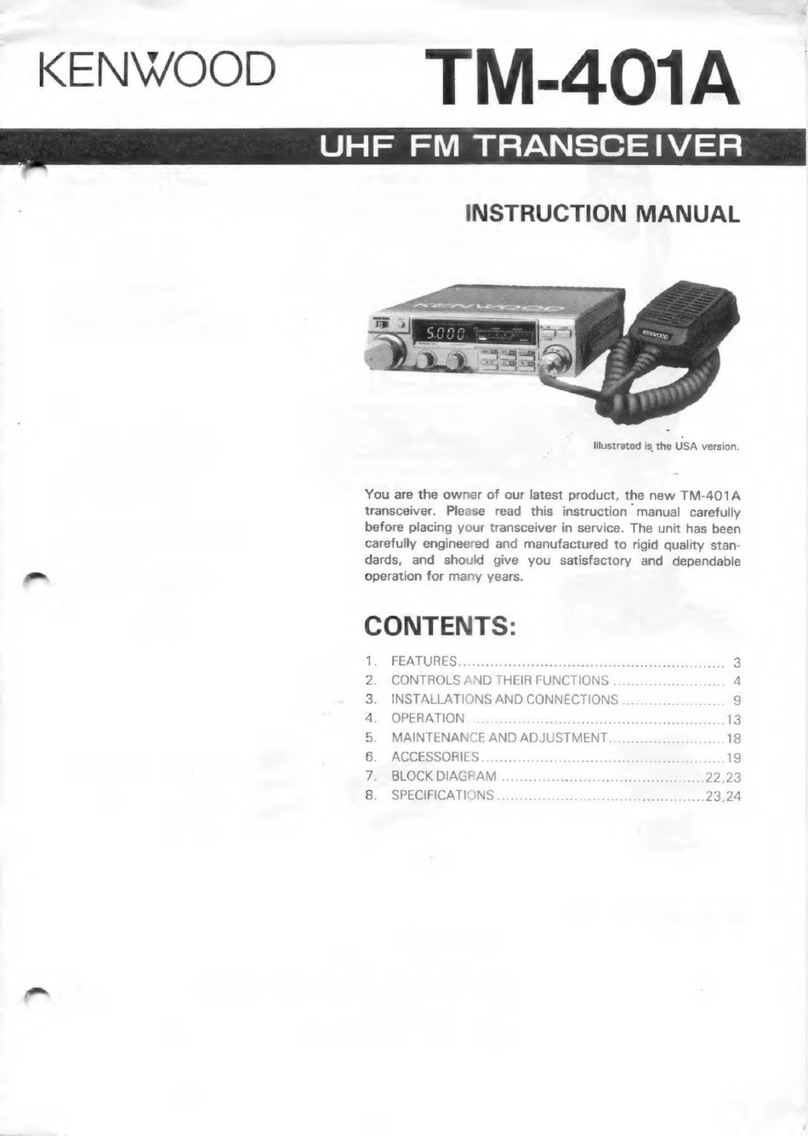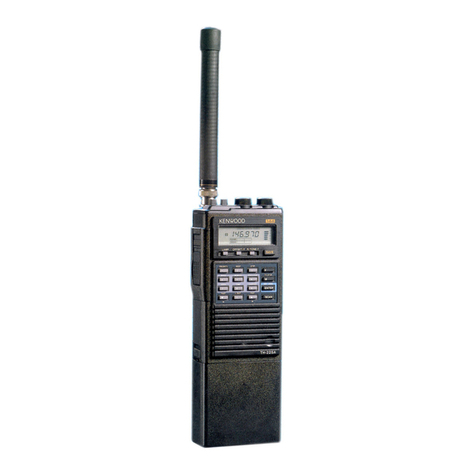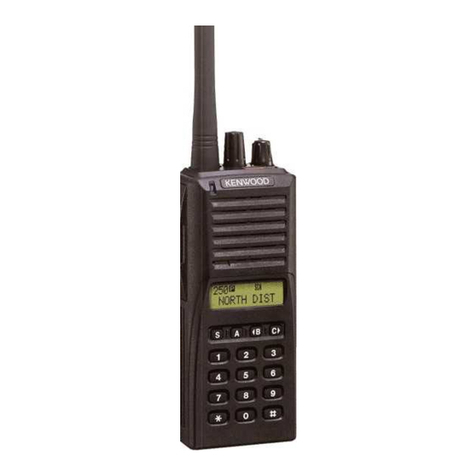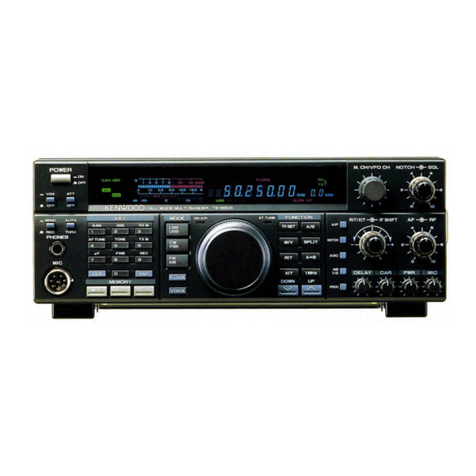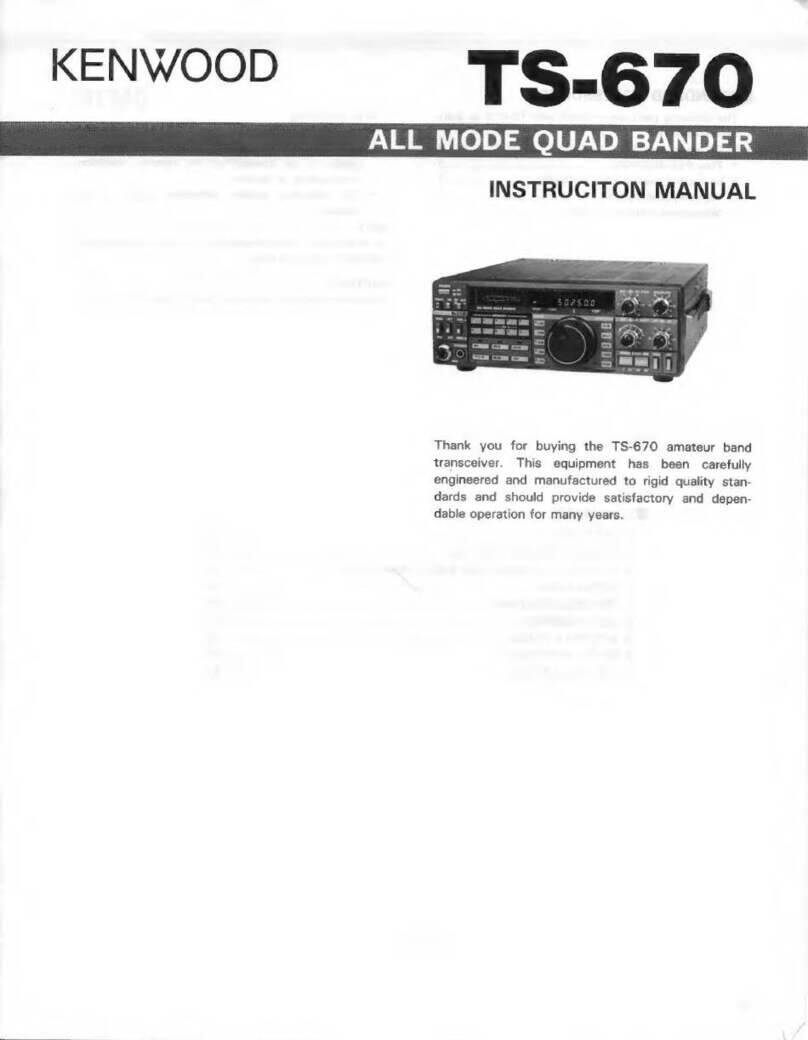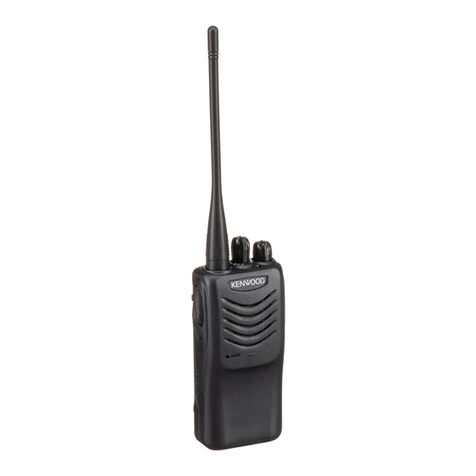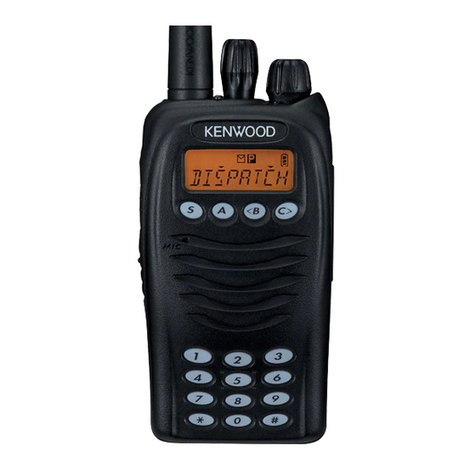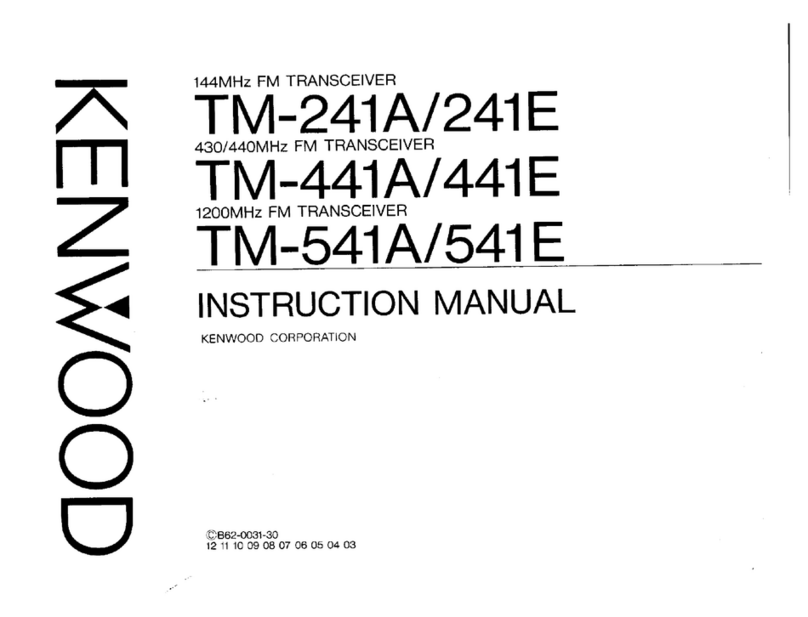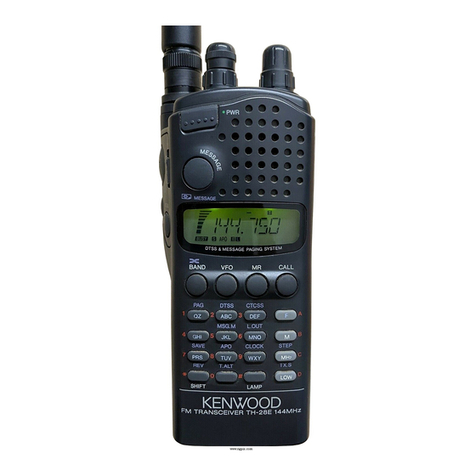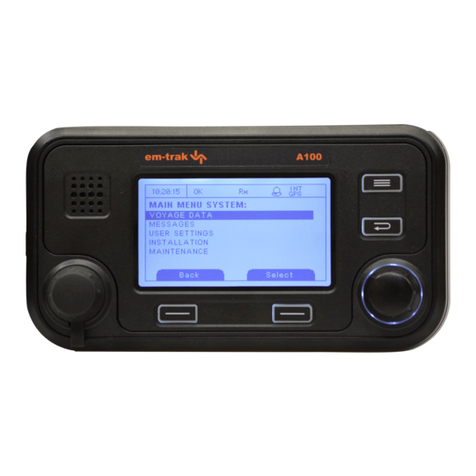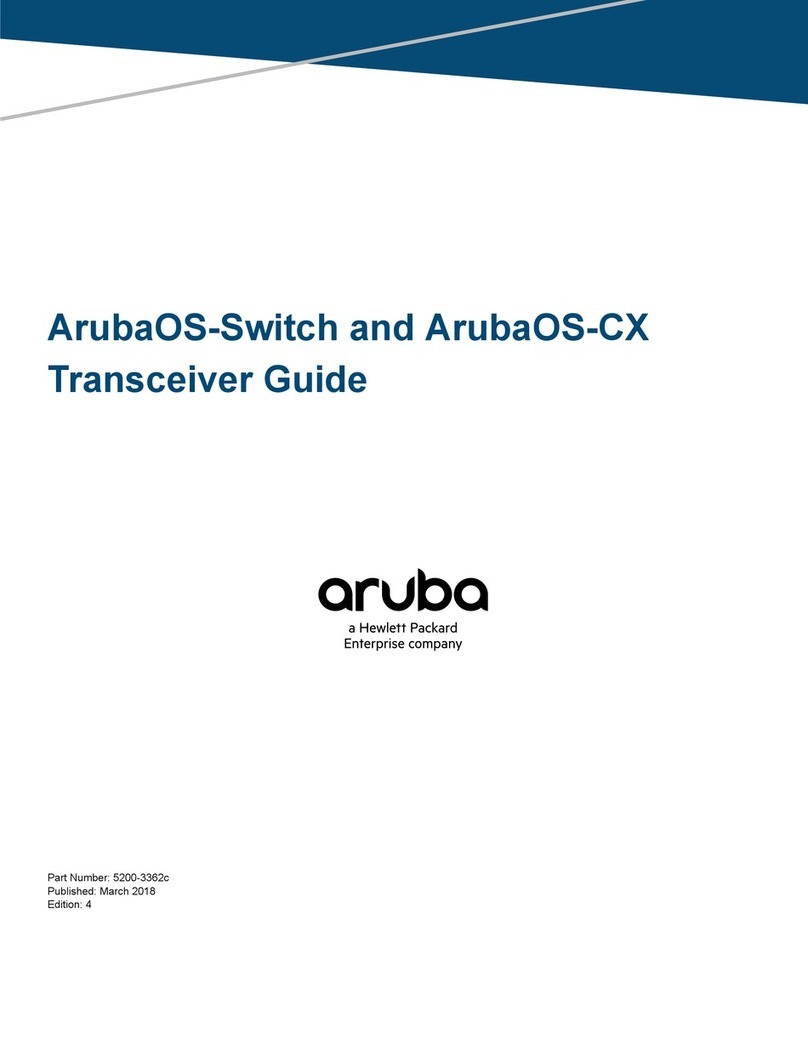
Pe
POU
SECTION
Ts
aN
uuHnoseHEdtncUntoscauntpocenegyscunyscuuatossnttnocenegnscyanosenetenccteney-cuttto-ctntts-cnuni
sa
1.1
KENWOOD
TS-830S
The
TS-830S
is
a
highly
sophisticated
solid
state
Amateur
band
transceiver
employing
only
three
vacuum
tubes.
Operating
on
all
Amateur
bands
between
1.8
and
29.7
MHz,
this
unit
is
constructed
modularly.
The
TS-830S
includes
many
built-in
features
usually
found
as
extras
on
other
transceivers.
Included
are
VOX,
25
kHz
calibrator,
RIT,
RF
attenuator,
and
an
effective
noise
blanker.
The
TS-830S
also
includes
automatic
gain
control
(AGC),
automatic
level
control
(ALC),
semi-break-in
CW
with
sidetone,
a
speech
processor,
speaker
and
built-in
AC
power
supply.
Designed
for
operation
on
SSB
or
CW,
the
TS-830S
delivers
more
than
220
watts
PEP
input.
Any
complicated
electronic
device
will
be
damaged
if
operated
incorrectly,
and
this
transceiver
is
no
exception.
Please
read
all
of
the
operating
instructions
before
putting
your
TS-830S
on
the
air.
1.2
FEATURES
1.
Interference-free
DX
operation
*
Variable
bandwidth
IF
filter
circuit
(VBT)
The
built-in
VBT
(Variable
Bandwidth
Tuning)
circuit
al-
lows
IF
filter
pass-bandwidth
to
be
varied
as
you
wish
to
eliminate
unpleasant
interference.
It
is
adjustable
independent
of
the
IF
Shift.
*IF
shift
circuit
The
IF
SHIFT
(also
called
pass-band
tuning)
is
a
circuit
to
shift
IF
pass-bandwidth
without
changing
receive
frequency.
It
eliminates
interference
or
adjusts
receive
frequency
characteristic
as
desired.
*
High
reliability
455
kHz
notch
circuit
Interference,
is
also
eliminated
by
the
built-in
notch
circuit.
The
TS-830S
uses
455
kHz
notch-frequency.
The
notch
circuit
shifts
the
BFO
frequency
and
the
local
mixer
frequency
at
the
same
time,
thereby
equiva-
lently
changing
the
notch
frequency.
Thus,
accurate
notch
characteristic
is
realized
even
when
the
notch
point
is
changed,
completely
eliminating
nearby
inter-
ference
signals.
*
NARROW/WIDE
BANDWIDTH
selection
and
optional
filters
for
enhanced
CW
operation:
NARROW
or
WIDE
CW
operation
can
be
selected
when
using
the
following
optional
filters:
YK-88C
(500
Hz),
YK-88CN
(270
Hz),
YG-455C
(500
Hz),
YG-455CN
(250
Hz)
*Variable
tone
control
circuit.
2.
WARC
bands
The
TS-830S
fully
covers
160-10
m
Amateur
bands,
including
the
new
WARC
bands
of
10,
18
and
24.5
MHz.
The
TS-830S
VFO
covers
more
than
50
kHz
above
and
below
each
500
kHz
band.
The
optional
VFO-230
external
digital
VFO
covers
about
100
kHz
above
and
below
each
band,
for
MARS
and
other
applications.
eancpescnuyyscunngnscngny
uuu
caunte
ct
INTRODUCTION
AND
FEATURES
i
3.
Self-contained,
compact
AC
Power
supply.
4.
Advanced
circuit
design
for
imporved
two-signal
char-
acteristics.
Cleverly
designed
front-end
circuit
compo-
nents
and
receive
circuit
system
assure
excellent
two-signal
characteristics.
Cross-modulation
and
blocking
are
reduced.
5.
TX
final
unit
uses
6146B’s
The
finals
are
a
pair
of
6146B
transmitting
tubes.
RF
negative
feed
back
and
amplified
ALC
provide
clear,
strong
signals
with
reduced
cross
modulation.
6.
Variable
level
noise
blanker
Conventional
fixed
level
noise
blankers
are
sometimes
less
than
effective
in
removing
pulsating
noise
over
weak
signals
or
rejecting
strong
interference
signals.
This
variable
level
noise
blanker
is
equipped
to
control
the
optimum
threshold
level
of
the
gate
pulse
amplifier.
7.
RF
speech
processor
to
increase
average
power
during
SSB
operation
This
is
an
RF
clipper
speech
processor,
using
both
the
455
kHz
and
8.83
MHz
IF’s.
Unwanted
frequency
components
are
removed
by
the
8.83
MHz
crystal
filter,
providing
a
compression
ratio
of
approximately
20
dB.
8.
Transmit
monitor
circuit
The
built-in
monitor
circuit
permits
easy
adjustment
of
the
RF
processor
and
mic
gain.
9.
XIT
(Transmit
Incremental
Tuning)
for
fine
adjustment
of
transmit
frequency
independent
of
receive
frequency.
10.
A
combination
of
precise,
easy-to-read
digital
frequency
indicator
and
an
analog
dial.
The
digital
indicator
has
a
Digital
Hold
memory
function.
11.
The
controls
are
arranged
on
the
die-cast
front
panel
for
easy
operation.
12.
A
full
variety
of
accessory
circuits
are
provided:
The
TS-830S
includes:
VOX
circuit
(available
for
Semi-Break-in),
Market
circuit,
side-tone
oscillator,
selectable
AGC
(OFF,
FAST,
SLOW),
RF
ATTENUATOR,
Fixed
crystal
oscillator
circuit,
Audio
frequency
characteristics
selector
circuit
for
each
mode,
CW
zero-beat
circuit,
IF
OUT-1
(for
BS-8
Pan
Display)
and
OUT-2
(for
RX
Display)
for
SM-220
Station
Monitor,
HEATER
switch,
Screen
Grid
switch,
and
a
Built-in
speaker.
